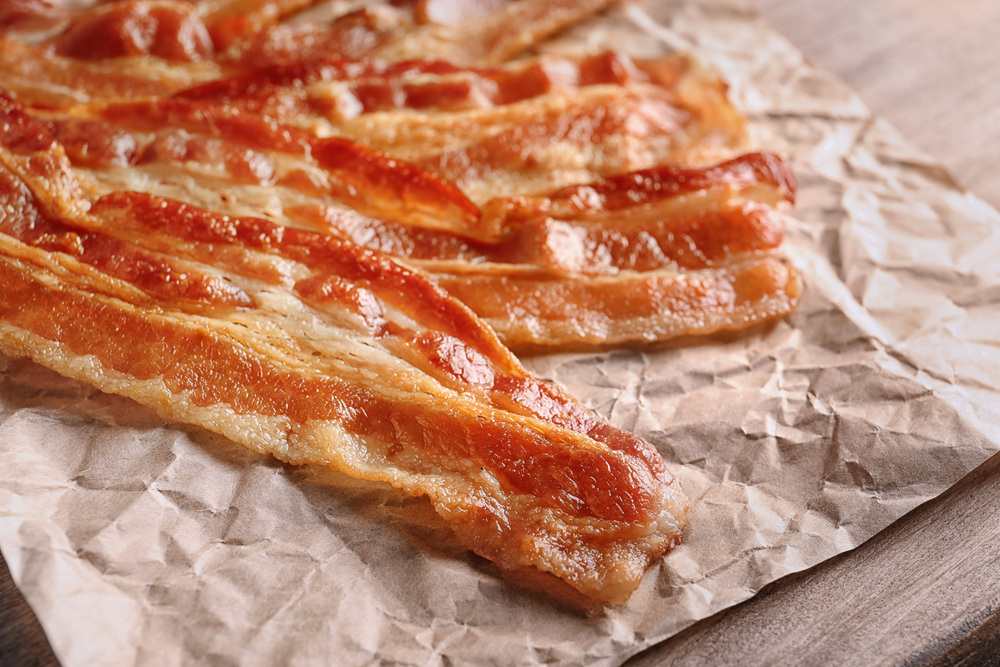As a complete protein source, bacon has all nine essential amino acids and is a good source of protein. Low in carbohydrates, a slice of bacon has three grams of protein and zero carbohydrates. It is a low-carb and low-glycemic food making it ideal for incorporating in low-carb diets.
Bacon is high in fat and is thought to be an unhealthy food that should only be eaten in small amounts to avoid health problems like heart disease and obesity. It is also very high in sodium. A slice of cured bacon cooked in the microwave contains 1. 9 grams of protein and 1. 9 grams of fat, while roasted or fried bacon contains 2. 96 grams of protein and 3. 34 grams of fat.
The fat in bacon is both saturated and unsaturated and one slice contains about 0. 6 grams of saturated fat when cooked in the microwave, and 1. 1 grams when pan-fried. A slice of bacon pan-fried contains 43 calories, 185 milligrams of sodium, and a milligram of calcium. There are 25 calories, 104 mg of sodium, and 1 mg of calcium in a slice of bacon cooked in the microwave.
There are many kinds of bacon, and some are healthier than others. 100 grams of boiled collar joint, which is what some bacon is made of, has iron, niacin, and vitamins B1 and B2. 100 grams of grilled gammon rasher, which is bacon made from the back legs’ tops, is full of iron, vitamin B1, and vitamin B2. A lot of niacin, vitamin B1, vitamin B2, iron, zinc, copper, and selenium can be found in 100 grams of fried streaky bacon.
Bacon in general is high in micronutrients. One slice of bacon contains 5 micrograms of selenium, 0. 9 micrograms of niacin, 43. 5 micrograms of phosphorous. Small amounts of iron, zinc, potassium, calcium, choline, folate, vitamin A, and vitamin B12 can also be found in bacon.
Bacon is a beloved breakfast food enjoyed by many. It’s tasty crispy, salty and goes great with eggs, toast, pancakes, you name it. But when cooking or meal planning with bacon, the common question arises – how much bacon should I cook? Specifically, how many slices of bacon make up 100g? Let’s take a closer look.
Getting to Know Bacon Weights and Sizes
First, it helps to understand how bacon is typically packaged and sold. Most supermarket bacon is sold in packs weighing somewhere between 300g to 500g. The bacon slices are thin cut and weigh around 20-25g each.
So a 500g pack would contain about 20 slices of bacon. A 300g pack would have 12-15 slices. These numbers are rough guides though, as bacon pack weights and slice sizes can vary between brands.
Bacon slice thickness can range from extra thin to thick cut Thinner slices weigh less than thicker slices Here are some averages
- Extra thin slice – 15g
- Thin slice – 20g
- Regular slice – 25g
- Thick slice – 30-35g
As you can see, bacon slice weights can fluctuate quite a bit. When meal planning or cooking, it’s best to go by the gram weight rather than number of slices.
How Many Slices in 100g of Bacon
So back to our original question – how many slices of bacon make up 100g?
Here is a quick estimate:
- 4 slices of extra thin bacon = 100g
- 3-4 slices of thin cut bacon = 100g
- 3-4 slices of regular cut bacon = 100g
- 2-3 slices of thick cut bacon = 100g
Based on average slice weights, 100g of bacon would be about 3 to 4 regular slices from a standard supermarket pack.
However, I suggest weighing slices on a kitchen scale for the most accuracy. Bacon densities and thicknesses vary quite a bit between brands, so weighing is better than guessing slice counts.
Here is a more precise bacon slice guide for 100g:
- 100g of extra thin bacon slices = 6-7 slices
- 100g of thin cut bacon slices = 4-5 slices
- 100g of regular cut bacon = 3-4 slices
- 100g of thick cut bacon = 2-3 slices
Weight to Slice Conversions
Here are some more common bacon weight and slice conversions:
- 50g bacon = 2-3 slices
- 150g bacon = 5-6 slices
- 200g bacon = 8-10 slices
- 250g bacon = 10-12 slices
- 300g bacon = 12-15 slices
- 450g bacon = 18-20 slices
- 500g bacon (full pack) = 20-25 slices
These ranges account for differences in slice thicknesses between brands. Again, the actual number of slices for a given weight can vary quite a bit. Weighing the slices is the most accurate way to portion bacon.
Tips for Measuring Bacon
Here are some tips for easily measuring out bacon:
-
Weigh slices uncooked. Bacon shrinks when cooked so weighing raw gives you the right portion size.
-
Use a digital kitchen scale for precision. Digital scales designed for food give the most accurate measurements.
-
Separate and stack slices on a plate to weigh. This prevents overlap and inaccuracies when weighing.
-
Note the brand and slice thickness. This helps determine slice counts for future reference.
-
Store extra bacon sealed and refrigerated. Reseal opened packs and use within 5-7 days for food safety.
Cooking with 100g of Bacon
Wondering how much cooked bacon you get from 100g of raw bacon? You can expect it to reduce by about 50% in size after cooking.
So 100g of raw bacon slices will shrink down to approximately 50g of cooked bacon. It will render out fat and the slices will become thinner and crisper.
A 100g portion of cooked bacon is great for:
- 2 servings of eggs and bacon
- 4 bacon cheeseburgers
- Bacon bits for 2 large salads
- Quiche, frittata, or omelette filling
- Potato or green salad topping
- Bacon jam or baked bean filling
- Carbonara or pasta sauce ingredient
You can stretch 100g of bacon even further for flavoring in soups, baked goods, roasted vegetables, etc. A little goes a long way!
Nutrition Facts for 100g Bacon
Here are the general nutrition facts for 100g of pan fried bacon:
- Calories: 417
- Total Fat: 32g
- Saturated Fat: 11g
- Cholesterol: 109mg
- Sodium: 1060mg
- Carbohydrates: 0g
- Protein: 29g
Bacon is high in saturated fat and sodium, which should be limited in a healthy diet. Enjoy it in moderation along with plenty of fruits, vegetables and whole grains.
Thespecific nutrition stats can vary depending on the brand, ingredients, and cooking method. Check package labels for details on a particular product. Turkey bacon tends to be slightly leaner than pork bacon.
The Takeaway
So to recap, the typical serving size of bacon is around 100g. This equates to approximately 3-4 slices of regular cut bacon from the supermarket. For the most accuracy, weigh the bacon raw on a kitchen scale. Then cook it up and enjoy it crispy in your favorite dishes!

Choosing that special gift is easier than ever!
Send a bacon gift box full of delicious bacon made in small shops by award-winning master butchers. It’s the perfect gift.
We went all over the United States looking for the best bacon, so now you can send a great bacon gift to anyone in the country with confidence. Click below to explore bacon gift boxes.
We offer a 100% satisfaction guarantee, which means that your bacon will arrive in perfect condition or we’ll replace it.
Explore our bacon gift box options by clicking the button below.

The Ultimate Guide to Bacon
As a complete protein source, bacon has all nine essential amino acids and is a good source of protein. Low in carbohydrates, a slice of bacon has three grams of protein and zero carbohydrates. It is a low-carb and low-glycemic food making it ideal for incorporating in low-carb diets.
Bacon is high in fat and is thought to be an unhealthy food that should only be eaten in small amounts to avoid health problems like heart disease and obesity. It is also very high in sodium. A slice of cured bacon cooked in the microwave contains 1. 9 grams of protein and 1. 9 grams of fat, while roasted or fried bacon contains 2. 96 grams of protein and 3. 34 grams of fat.
The fat in bacon is both saturated and unsaturated and one slice contains about 0. 6 grams of saturated fat when cooked in the microwave, and 1. 1 grams when pan-fried. A slice of bacon pan-fried contains 43 calories, 185 milligrams of sodium, and a milligram of calcium. There are 25 calories, 104 mg of sodium, and 1 mg of calcium in a slice of bacon cooked in the microwave.
There are many kinds of bacon, and some are healthier than others. 100 grams of boiled collar joint, which is what some bacon is made of, has iron, niacin, and vitamins B1 and B2. 100 grams of grilled gammon rasher, which is bacon made from the back legs’ tops, is full of iron, vitamin B1, and vitamin B2. A lot of niacin, vitamin B1, vitamin B2, iron, zinc, copper, and selenium can be found in 100 grams of fried streaky bacon.
Bacon in general is high in micronutrients. One slice of bacon contains 5 micrograms of selenium, 0. 9 micrograms of niacin, 43. 5 micrograms of phosphorous. Small amounts of iron, zinc, potassium, calcium, choline, folate, vitamin A, and vitamin B12 can also be found in bacon.
Is two slices of bacon healthy?
FAQ
How many grams is 3 slices of bacon?
How many grams is a piece of bacon?
How many slices of bacon is 200 grams?
How much bacon is 10 slices?
